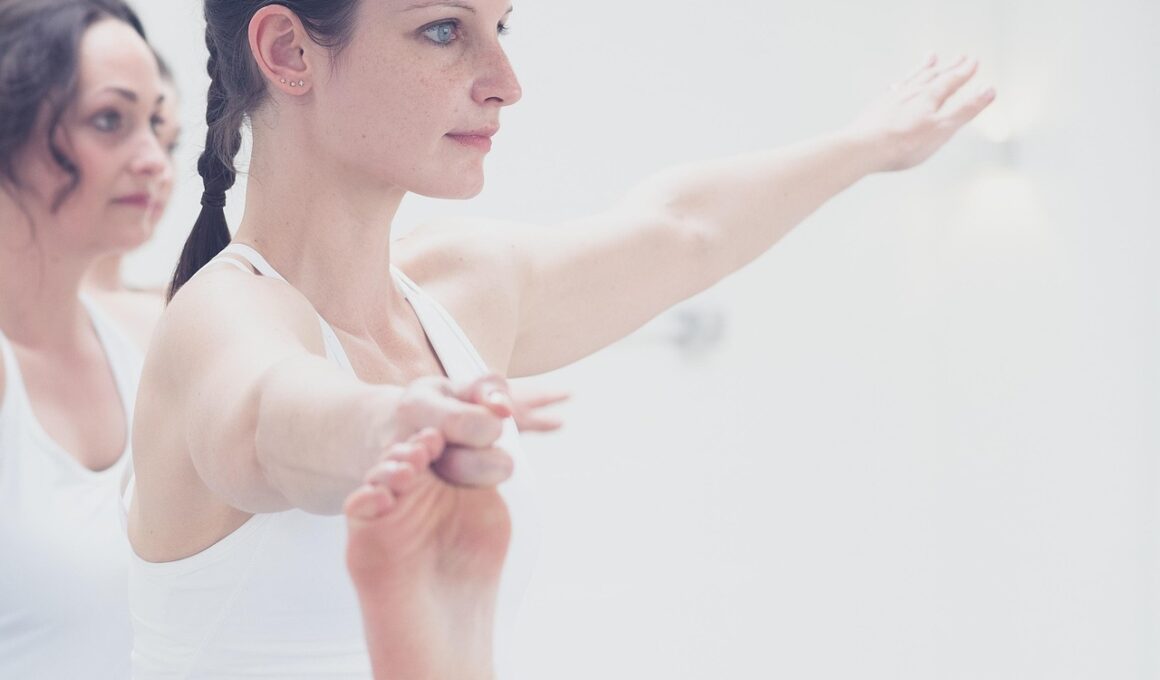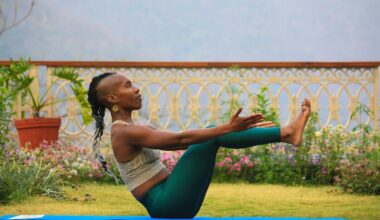Using Mobility Training to Prevent Overuse Injuries in Triathlon
Triathletes often find themselves in a constant battle between performance enhancement and injury prevention. This is where mobility training becomes essential. Flexibility and mobility help athletes maintain a balanced range of motion, preventing injuries caused by overuse. When muscles and joints are stiff, they lack the necessary flexibility needed for the varied motions in swimming, cycling, and running. Overuse injuries, such as tendinitis and muscle strains, commonly occur among triathletes who skip mobility exercises. Implementing a dedicated mobility routine can significantly reduce risks. Stretch routines tailored for triathletes focus on hip flexors, hamstrings, and shoulders. These areas are critically involved in triathlon performance, as they help maintain proper posture and movement during events. Developing a routine to promote flexibility can lead to improved athletic performance. Consequently, incorporating mobility training with dynamic stretches can help foster resilience in soft tissues, aiding recovery. Regular participation in mobility sessions fosters not only flexibility but enhances overall biomechanics, contributing to injury-free training. Triathletes should view mobility training as a proactive approach to enduring performance across multiple sports. Embrace consistency in mobility training as a means to achieve long-term athletic success.
When discussing the importance of mobility, it is crucial to distinguish between flexibility and mobility. Flexibility refers to the range of motion of a muscle, while mobility encompasses the ability to move freely while maintaining stability in joints. Each promotes different aspects of athletic performance. The tightness or limitations in muscle or joint movement can lead to compensatory patterns. Such patterns often trigger injuries over time. Triathletes typically experience discomfort due to repetitive use of the same muscles. Regular mobility work helps mitigate tightness, enhancing your ability to move fluidly. Stretching techniques, such as dynamic warm-ups, can greatly improve your range of motion. These warm-ups should be tailored to the specific demands of triathlons. Establishing a comprehensive warm-up routine that integrates foam rolling, dynamic stretching, and mobility drills should be standard for athletes. Foam rolling sessions help break down adhesions in the muscles, promoting greater mobility. Additionally, a combination of mobility exercises leads to better functional movement patterns. Enhancing coordination and joint stability allows for more effective swimming strokes, powerful cycling, and efficient running mechanics. Ultimately, triathletes should prioritize flexibility and mobility in their training plan.
Key Mobility Exercises for Triathletes
Incorporating specific mobility exercises into your training routine can significantly enhance your performance and reduce your risk of injuries. A focus on the joints most affected by triathlon training is vital. For example, hip openers like the pigeon stretch and the hip flexor lunge can improve hip mobility. Incorporating these movements before workouts fosters better posture and efficiency as athletes perform their exercises. Another critical area is the spine; performing thoracic spine rotations helps maintain proper spinal alignment. Moreover, stretching the shoulders helps alleviate tension built during swim training. A simple doorway stretch can help release tightness across the chest. Balance and strength exercises should complement mobility work. Incorporating single-leg balance drills can enhance proprioception, aiding coordination during runs and rides. Resistance bands can also be used for lateral leg raises, promoting glute activation for better power output while cycling. Emphasizing these exercises in daily training helps athletes maintain strength while remaining agile and mobile. These steps can elevate athletic performance in competition effectively. As you integrate these exercises, aim for consistency, gradually increasing intensity as strength and mobility improve.
Recovery plays an integral role in a triathlete’s journey to peak fitness and performance. A significant component of recovery is mobility training. Post-workout stretching routines can ease tight muscles and prevent stiffness, fostering overall body recovery. Incorporating foam rolling into your regimen focuses on muscle recovery and accelerates tissue healing. Many athletes can benefit from spending time on self-myofascial release techniques to soften connective tissues and trigger points. This enhances blood flow and alleviates muscle soreness. Research indicates that active recovery strategies are more beneficial than static rest. Activities such as yoga and light swim sessions can promote blood circulation. This, in turn, assists in the removal of metabolic waste produced during high-intensity workouts. Both techniques emphasize flexibility and mindfulness, helping athletes remain physically and mentally prepared for upcoming training sessions. Additionally, building time for rest and mobility within weekly training plans is crucial. Scheduled rest days should include mobility and stretching sessions to ensure effective rejuvenation. Triathletes should always listen to their bodies post-training, respecting any signs of discomfort. Prioritizing active recovery can enhance performance and ultimately lead to better race outcomes.
The Role of Consistency in Mobility Training
Consistency plays a vital role in reaping the full benefits of mobility training. An erratic approach to flexibility and mobility exercises may result in minimal progress, undoing the efforts spent in improving performance. Establishing a structured and habitual routine is essential for maximizing results. Athletes often reach plateaus when neglecting mobility work. Regularly scheduled mobility sessions should become an inherent part of your training protocol. Designate specific days for mobility-focused workouts, incorporating both dynamic movements and static stretches. Collaborating with a coach can provide personalized mobility plans for specific needs. Periodically assessing flexibility gains ensures that adjustments can be made as your performance requirements evolve. Track your progress in mobility routines alongside training journals to highlight improvements. Setting achievable goals can maintain motivation throughout the training season as well. For example, aim for a specific number of repetitions or duration of holds for stretches. Include scheduled progress assessments to keep mind and body engaged. Celebrate small wins to bolster enthusiasm for continued practice. Ultimately, triathletes who commit to enhancing their mobility will reap benefits, resulting in reduced injury risks and improved race results.
Incorporating mobility assessments into your routine can identify areas needing improvement and track progress. Performing regular assessments helps to provide a baseline for flexibility and mobility. Triathletes should conduct simple tests focusing on range of motion. Examples include the sit-and-reach test to gauge hamstring and lower back flexibility. Another effective assessment is the shoulder flexion test, which highlights possible limitations impacting swim performance. Regular assessments inform training modifications, ensuring alignment with athletes’ needs. If certain muscle groups reveal significant tightness, tailor your mobility work to target these areas more intensively. Feedback from measurements enhances motivation and commitment to mobility practices. Use tools like apps to track performance over time. The data gathered can help monitor your responsiveness to mobility enhancements. These insights guide gradual adjustments to developing mobility routines over time. Triathletes can share assessment results with coaches or training partners to foster accountability. Transparency in your mobility journey encourages group support. Aligning goals with others ultimately cultivates a culture of progress. Ultimately, regular assessments pave the way toward improving mobility, leading to pain-free training and optimal performance.
Conclusion: Empowering Your Triathlon Journey
In conclusion, mobility training is an indispensable component of successful triathlon training. By prioritizing flexibility and mobility, athletes can substantially reduce their risk of overuse injuries while simultaneously enhancing performance. Implementing a structured routine consisting of tailored exercises and consistent practice can safeguard against the physical toll of intense training. Addressing mobility not only improves joint health, but also allows athletes to adapt to various physical demands inherent in triathlons. Thus, developing fundamental flexibility routines, incorporating thorough warm-ups, and committing to mobility assessments become pillars of a robust training schedule. Emphasis on recovery and active practices will yield great benefits. Athletes should embrace mobility training as a necessity rather than a supplement to training. Through dedication to these practices, triathletes can unlock their true potential and achieve their performance goals. Remember, successful triathletes do not only rely on endurance; they also acknowledge the importance of flexibility and mobility. To excel, consider mobility training as a crucial aspect of your athletic life. Empower yourself with these tools to face challenges confidently and joyfully within your triathlon journey.
Moreover, engaging various forms of mobility training ensures that athletes remain challenged and excited about their routines. Incorporating playful elements such as partner mobilization drills can turn training into a fun experience while still yielding substantial benefits. Triathletes maintain long-term health and resilience by understanding that injury prevention encompasses not just physical preparations but also an engaging mindset. Embrace a holistic view of your training program as you embark on the journey toward triathlon success. Adopting this comprehensive perspective will encourage you to continually explore novel mobility methodologies. It opens up opportunities for personal growth and mastery of the aspects needed for maintaining competitive edge. Ultimately, improving your mobility will lead to noticeable enhancements in all three segments of a triathlon. Develop a strong foundation of flexibility and mobility to assure longevity in your sporting endeavors. Stay proactive regarding your training choices, prioritizing the elements that serve your needs best. Consistently embody a mindset of exploration and curiosity over time. Find joy in the ever-evolving training process while you chase meaningful athletic goals. This commitment will ensure ongoing improvement on your triathlon journey and beyond.


